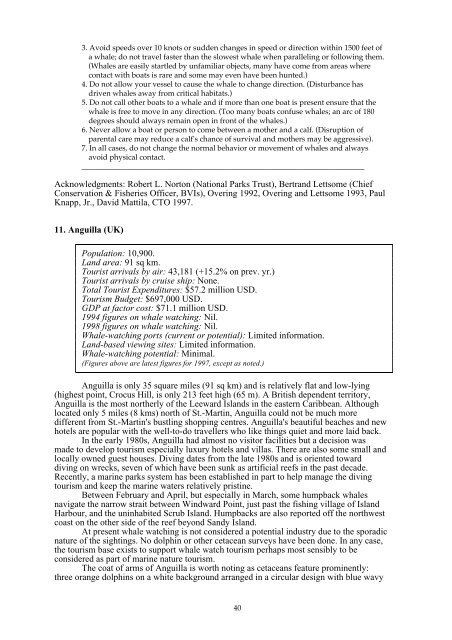The Potential of Whale Watching in the Caribbean: 1999+
The Potential of Whale Watching in the Caribbean: 1999+
The Potential of Whale Watching in the Caribbean: 1999+
Create successful ePaper yourself
Turn your PDF publications into a flip-book with our unique Google optimized e-Paper software.
3. Avoid speeds over 10 knots or sudden changes <strong>in</strong> speed or direction with<strong>in</strong> 1500 feet <strong>of</strong><br />
a whale; do not travel faster than <strong>the</strong> slowest whale when parallel<strong>in</strong>g or follow<strong>in</strong>g <strong>the</strong>m.<br />
(<strong>Whale</strong>s are easily startled by unfamiliar objects, many have come from areas where<br />
contact with boats is rare and some may even have been hunted.)<br />
4. Do not allow your vessel to cause <strong>the</strong> whale to change direction. (Disturbance has<br />
driven whales away from critical habitats.)<br />
5. Do not call o<strong>the</strong>r boats to a whale and if more than one boat is present ensure that <strong>the</strong><br />
whale is free to move <strong>in</strong> any direction. (Too many boats confuse whales; an arc <strong>of</strong> 180<br />
degrees should always rema<strong>in</strong> open <strong>in</strong> front <strong>of</strong> <strong>the</strong> whales.)<br />
6. Never allow a boat or person to come between a mo<strong>the</strong>r and a calf. (Disruption <strong>of</strong><br />
parental care may reduce a calf's chance <strong>of</strong> survival and mo<strong>the</strong>rs may be aggressive).<br />
7. In all cases, do not change <strong>the</strong> normal behavior or movement <strong>of</strong> whales and always<br />
avoid physical contact.<br />
______________________________________________________________<br />
Acknowledgments: Robert L. Norton (National Parks Trust), Bertrand Lettsome (Chief<br />
Conservation & Fisheries Officer, BVIs), Over<strong>in</strong>g 1992, Over<strong>in</strong>g and Lettsome 1993, Paul<br />
Knapp, Jr., David Mattila, CTO 1997.<br />
11. Anguilla (UK)<br />
Population: 10,900.<br />
Land area: 91 sq km.<br />
Tourist arrivals by air: 43,181 (+15.2% on prev. yr.)<br />
Tourist arrivals by cruise ship: None.<br />
Total Tourist Expenditures: $57.2 million USD.<br />
Tourism Budget: $697,000 USD.<br />
GDP at factor cost: $71.1 million USD.<br />
1994 figures on whale watch<strong>in</strong>g: Nil.<br />
1998 figures on whale watch<strong>in</strong>g: Nil.<br />
<strong>Whale</strong>-watch<strong>in</strong>g ports (current or potential): Limited <strong>in</strong>formation.<br />
Land-based view<strong>in</strong>g sites: Limited <strong>in</strong>formation.<br />
<strong>Whale</strong>-watch<strong>in</strong>g potential: M<strong>in</strong>imal.<br />
(Figures above are latest figures for 1997, except as noted.)<br />
Anguilla is only 35 square miles (91 sq km) and is relatively flat and low-ly<strong>in</strong>g<br />
(highest po<strong>in</strong>t, Crocus Hill, is only 213 feet high (65 m). A British dependent territory,<br />
Anguilla is <strong>the</strong> most nor<strong>the</strong>rly <strong>of</strong> <strong>the</strong> Leeward Islands <strong>in</strong> <strong>the</strong> eastern <strong>Caribbean</strong>. Although<br />
located only 5 miles (8 kms) north <strong>of</strong> St.-Mart<strong>in</strong>, Anguilla could not be much more<br />
different from St.-Mart<strong>in</strong>'s bustl<strong>in</strong>g shopp<strong>in</strong>g centres. Anguilla's beautiful beaches and new<br />
hotels are popular with <strong>the</strong> well-to-do travellers who like th<strong>in</strong>gs quiet and more laid back.<br />
In <strong>the</strong> early 1980s, Anguilla had almost no visitor facilities but a decision was<br />
made to develop tourism especially luxury hotels and villas. <strong>The</strong>re are also some small and<br />
locally owned guest houses. Div<strong>in</strong>g dates from <strong>the</strong> late 1980s and is oriented toward<br />
div<strong>in</strong>g on wrecks, seven <strong>of</strong> which have been sunk as artificial reefs <strong>in</strong> <strong>the</strong> past decade.<br />
Recently, a mar<strong>in</strong>e parks system has been established <strong>in</strong> part to help manage <strong>the</strong> div<strong>in</strong>g<br />
tourism and keep <strong>the</strong> mar<strong>in</strong>e waters relatively prist<strong>in</strong>e.<br />
Between February and April, but especially <strong>in</strong> March, some humpback whales<br />
navigate <strong>the</strong> narrow strait between W<strong>in</strong>dward Po<strong>in</strong>t, just past <strong>the</strong> fish<strong>in</strong>g village <strong>of</strong> Island<br />
Harbour, and <strong>the</strong> un<strong>in</strong>habited Scrub Island. Humpbacks are also reported <strong>of</strong>f <strong>the</strong> northwest<br />
coast on <strong>the</strong> o<strong>the</strong>r side <strong>of</strong> <strong>the</strong> reef beyond Sandy Island.<br />
At present whale watch<strong>in</strong>g is not considered a potential <strong>in</strong>dustry due to <strong>the</strong> sporadic<br />
nature <strong>of</strong> <strong>the</strong> sight<strong>in</strong>gs. No dolph<strong>in</strong> or o<strong>the</strong>r cetacean surveys have been done. In any case,<br />
<strong>the</strong> tourism base exists to support whale watch tourism perhaps most sensibly to be<br />
considered as part <strong>of</strong> mar<strong>in</strong>e nature tourism.<br />
<strong>The</strong> coat <strong>of</strong> arms <strong>of</strong> Anguilla is worth not<strong>in</strong>g as cetaceans feature prom<strong>in</strong>ently:<br />
three orange dolph<strong>in</strong>s on a white background arranged <strong>in</strong> a circular design with blue wavy<br />
40
















